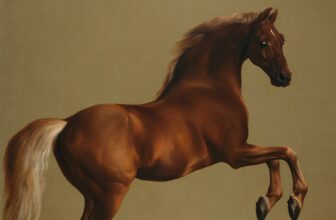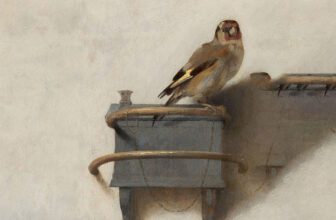
A Journey into Rosa Bonheur’s The Horse Fair
It is Paris, 1850. The streets are slick with morning mist, and the scent of horses clings to the air like a memory. Down the Boulevard de l’Hôpital, near the Salpêtrière Hospital, a rhythmic pounding of hooves echoes across the cobblestones. Shouts of handlers mix with the neighing of powerful beasts, their coats gleaming under the rising sun. The Horse Fair is in full force, a spectacle of motion, muscle, and mastery.
It was here, in this raw, masculine domain of trade and thunder, that a young woman named Rosa Bonheur quietly observed. Dressed in men’s clothes, against convention and social norm, she studied the way the horses reared, strained, and wheeled. She took notes not just with pencil and paper, but with the eyes of someone who could translate motion into majesty. These moments would later become her masterpiece: The Horse Fair.
The Artist Behind the Canvas: Who Was Rosa Bonheur?
Rosa Bonheur (1822–1899) was a French artist renowned in her time for her unparalleled skill in painting animals. In a world dominated by male artists, Bonheur carved her own path. Raised in a family of artists and free thinkers, she rejected traditional roles prescribed to women and pursued a rigorous artistic education, mostly self-directed, focused on anatomical precision and observation of nature.
Bonheur wasn’t just a painter, she was a phenomenon. Known for her independent spirit, she received special permission from the French government to wear men’s clothing so she could more easily visit places like slaughterhouses and fairs, where women were not typically welcomed. She understood animals deeply, not just their forms but their energy, their will.
It was this fascination and respect for the animal kingdom that culminated in her magnum opus, The Horse Fair, a painting that would not only solidify her legacy but also become one of the most celebrated animal paintings in Western art.
The Horse Fair: What’s Happening in the Painting?
When you stand before The Horse Fair, the first sensation is sheer motion. A wide panorama unfolds: a procession of draft horses, massive, snorting, full of primal energy, are paraded by handlers clad in working clothes. The horses twist and turn, some rearing, others galloping or pulling at the reins. The energy is barely contained, and yet it’s meticulously composed.
Set in the outskirts of Paris, the scene depicts the biweekly horse market that took place at the Boulevard de l’Hôpital. This market wasn’t a gentle affair. It was loud, boisterous, and physical, a place of commerce and power, where men showcased the strength and temperament of their horses to potential buyers.
Bonheur does not idealize the event. Instead, she plunges the viewer into it. You can almost hear the clatter of hooves, the rough voices of traders, the metallic jingle of harnesses. Horses are the true protagonists, vivid and vibrant, painted with anatomical accuracy and expressive flair.
The men are present but secondary. They wrestle and control, yet they are mere mortals beside these titanic beasts. Even in their struggle to tame the animals, there’s a sense that nature still holds the upper hand.
The Meaning of The Horse Fair
At its core, The Horse Fair is a celebration of power, both natural and artistic. The horses, rendered in dynamic poses with every sinew and muscle accounted for, are a testament to Bonheur’s fascination with physicality and movement. But beyond its literal representation of a horse market, the painting invites deeper interpretations.
Symbol of Freedom and Strength: In a time when women were expected to paint flowers and domestic scenes, Bonheur chose the wild, masculine world of horses. Her depiction of these animals, unrestrained, muscular, untamed, is almost autobiographical. They are her stand-ins: creatures of vitality that refuse to be boxed in by societal expectations.
Nature Versus Control: The recurring motif of humans trying to manage or dominate horses speaks to broader themes of control versus chaos, civilization versus nature. Bonheur does not side entirely with either force. Instead, she illustrates the constant tension and coexistence between them.
A Political Subtext? Some art historians have suggested the painting subtly critiques the hierarchy and industrialization of the time. Horses were central to labor and commerce, yet here they appear almost noble, more dignified than the men handling them. It may reflect Bonheur’s sympathy with the working class and animals alike, both subjected to society’s control.
Personal Declaration: For Bonheur, The Horse Fair was a statement. It was her boldest, most ambitious work, intended to establish her on the same level as great history painters. And it worked. The sheer scale and grandeur of the painting demanded that she be taken seriously, not as a woman who painted, but as a master artist.
Style and Technique: What Type of Art Is The Horse Fair?
The Horse Fair is a quintessential example of Realism, an artistic movement that emerged in mid-19th century France as a reaction against Romanticism and Neoclassicism. Realist painters sought to portray life as it truly was, gritty, dynamic, and sometimes unglamorous.
Bonheur’s approach was rooted in observation and anatomical accuracy. She spent countless hours sketching horses from life, even dissecting animal carcasses to understand muscle structures. Her painting reflects a scientific curiosity blended with expressive dynamism.
However, the work also exhibits a touch of Romantic grandeur. The sweeping composition, the dramatic lighting, and the almost theatrical staging of the horses add a sense of drama that transcends pure documentation.
It bridges Realism and Romanticism, combining the factual precision of the former with the emotional power of the latter.
Technically, Bonheur employed oil on canvas, using a muted palette of earthy tones to focus attention on form and movement. She painted large, massive, in fact. The finished piece measures over 8 feet high and 16 feet wide, asserting its presence like a mural of modern myth.
Where Is The Horse Fair Painting Now?
Today, The Horse Fair resides in the Metropolitan Museum of Art in New York City. It was acquired by Cornelius Vanderbilt in 1887 and donated to the museum, where it remains a highlight of the 19th-century European paintings collection.
There are also several smaller versions and studies of the painting, including one at the National Gallery in London. Bonheur herself created replicas and preliminary works, some of which are scattered in museums across Europe.
Standing before the original at the Met, viewers are often struck by its sheer scale. It is not merely a painting; it’s an experience, pulling you into another time, another world, where horses ruled the streets and an artist dared to defy every rule.
The Legacy of The Horse Fair
Bonheur’s The Horse Fair was a critical and commercial triumph. It was exhibited at the Paris Salon of 1853 to widespread acclaim, and later toured England and America. Queen Victoria herself requested a private viewing, and Bonheur was awarded the Legion of Honor, the first woman to receive such a distinction for artistic achievement.
But perhaps the most enduring legacy of The Horse Fair is its defiance. It defied gender norms, artistic conventions, and societal expectations. It showed that beauty could be found in brute strength, that elegance could emerge from chaos, and that a woman, with enough determination, could paint her way into history.
Today, Bonheur’s name may not be as instantly recognizable as her male contemporaries, but The Horse Fair continues to gallop through the annals of art history, a living, breathing, thunderous reminder of what true artistic freedom looks like.
Why The Horse Fair Still Matters
More than 170 years after it was painted, The Horse Fair remains a work of stunning vitality. In our digital age, where attention spans flicker and the world feels increasingly virtual, Bonheur’s canvas grounds us in something real, muscle, mud, motion.
It’s not just a picture of horses. It’s a testament to an artist’s will. To be seen. To be heard. To show the world what she saw and how fiercely she believed in it.
In every rearing stallion and straining sinew, we see Rosa Bonheur herself, undaunted, powerful, unforgettable.




